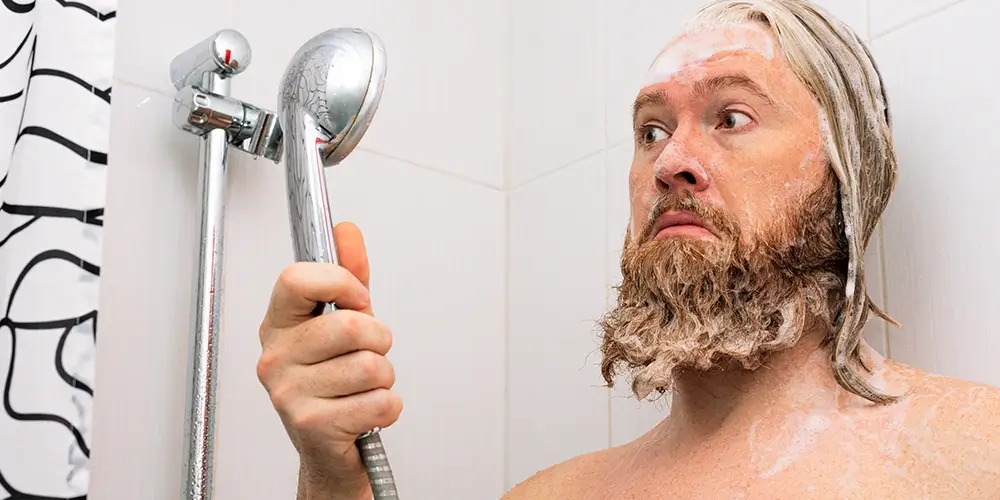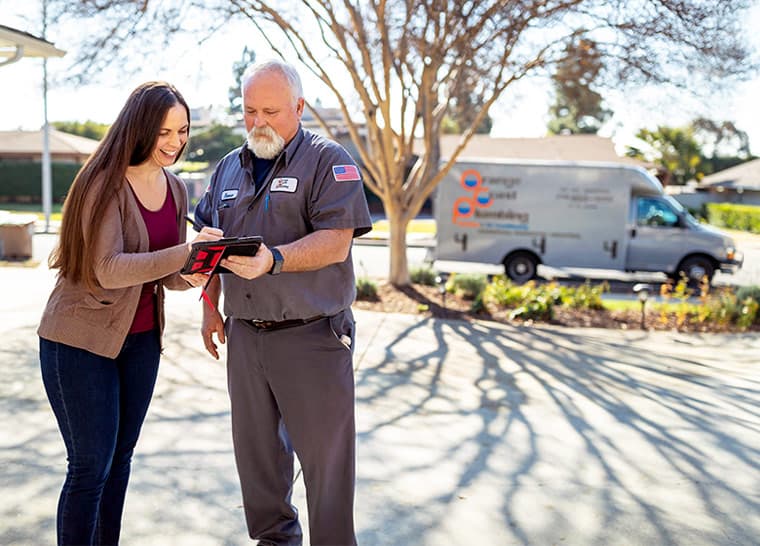Nothing gets the blood flowing like a nice, lukewarm shower. It’s almost as refreshing as lukewarm coffee or room-temperature pizza.
Obviously, we’re being facetious.
Wim Hoff loves his ice baths, but most people prefer to see the steam rise before they step into the shower. So, it may be time to investigate when the shower head spits out water at the temperature of summer rain.
The first place to look is the water heater (surprise!). Is it between 120 and 140 degrees Fahrenheit (140 being the maximum safe temperature)? If not, turn up the dial.
Otherwise, before you call a plumber, here are some things to check out:
1. Pilot Light Failure
In gas heaters, the pilot light ignites the gas burner that heats the water in your tank.
If it goes out, the burner won’t ignite. Various reasons, such as a faulty thermocouple, a draft blowing the light out, or a buildup of residue affecting the gas flow, could be responsible for this.
To troubleshoot:
- Is the pilot flame visible? If not, try relighting it according to the manufacturer’s instructions, which are usually found on the heater.
- If the light won’t stay lit or there are signs of significant soot buildup, you may have to clean the unit or replace the thermocouple.
- Call a professional plumber if you’re uncomfortable performing these tasks. A botched gas heater repair is a danger to your health and home.
2. Sediment Buildup
Water heaters accumulate sediment over time, especially if you have hard water. These deposits can cover the heating element or gas burner, reducing efficiency.
To troubleshoot:
- Attach a hose to the drain valve at the bottom of the heater. Drain a few gallons. This can remove some floating sediment.
- If the situation doesn’t improve, consider flushing your water heater. This drains the tank completely, removing much of the sediment.
- Call a professional to descale the tank or replace the water heater if the sediment is too thick for a full flush.
3. Malfunctioning Heating Element
Electric water heaters have two heating elements. When one malfunctions, you might get lukewarm water rather than hot. These elements can fail due to normal wear and tear, a mineral buildup reducing heat conductivity.
To troubleshoot:
- Turn off the power to the water heater.
- Use a multimeter to test each element for continuity.
- If an element lacks continuity, replace it.
Replacing a heating element is straightforward for an accomplished DIYer. At this point, though, most homeowners will contact a professional.
4. Malfunctioning Thermostat
The thermostat controls the water temperature. It may not signal the heating elements to heat the water to the desired temperature if defective.
Scalding water can lead to burns, while too-cold water can affect your health and comfort.
To troubleshoot:
- Check the Thermostat Settings: Ensure they’re set to the recommended temperature range, usually between 120 and 140 degrees Fahrenheit.
- Test the Thermostat: With the power off, use a multimeter to test the thermostat for continuity. If there’s no continuity, the thermostat may need replacing.
- Reset the Thermostat: Look for a reset button and press it to reset the internal programming of the thermostat.
- Replace the Thermostat: If troubleshooting doesn’t resolve the issue, call a professional to perform further tests and possibly replace the thermostat.
5. Broken Dip Tube
The dip tube directs cold water to the bottom of the tank to be heated. A broken dip tube can allow cold water to mix with the hot water, reducing its temperature.
To troubleshoot:
- Check for Leaks: A broken dip tube can cause leaks in your water heater. If you notice a leak, call a professional immediately.
- Inspect the Dip Tube: Shut off the power to the heater and remove the access panel. Locate the dip tube (usually on the top of the tank) and inspect it for cracks or breaks. If damaged, you’ll need to replace it.
6. Overused or Undersized Water Heater
An overused or undersized water heater struggles to keep up with the continuous need for hot water, especially during peak usage.
The constant strain can also reduce the water heater’s lifespan by causing more wear and tear than it’s designed to handle.
To troubleshoot:
- Evaluate Hot Water Needs: Does your current water heater’s capacity align with your needs? Analyze factors like the number of residents, typical water use patterns, and simultaneous hot water requirements (shower, dishwasher, washing machine, etc.).
- Upgrade or Replace the Water Heater: If your water heater is old or undersized, consider upgrading to a larger capacity model or installing an additional unit. Modern water heaters are more efficient and can provide a better hot water supply.
- Implement a Hot Water Schedule: Schedule hot water use during different times of the day to avoid peaking.
- Regular Maintenance: This includes checking for leaks, flushing the tank to remove sediment, and inspecting the anode rod to keep your water heater in good condition.
Conclusion
With basic knowledge and tools, you can often resolve hot water issues without professional help.
However, if the repair lies beyond your DIY comfort zone or the issue persists, leave the job to a licensed plumber. Gas and electricity are dangerous, and a mistake in handling your water heater can lead to severe injury or even death.
In Orange and South Los Angeles Counties, Orange Coast Plumbing is the service of choice for water heaters, slab leaks, repiping, and anything else that concerns plumbing. We’ve been in business since 1977 and have a dedicated crew prepared to respond to emergencies, even on holidays.
Call us today for all your plumbing needs! And please continue to explore our blog to learn more about DIY plumbing.
FAQs: More about Hot Water Problems
Q: Why isn’t my water heater producing hot water?
This could be due to a malfunctioning thermostat, a broken heating element, or sediment buildup affecting the heating process, among other things.
Q: How can I tell if my water heater’s heating element is broken?
Test the heating element with a multimeter for continuity. A lack of continuity suggests the element is broken and needs replacement.
Q: How often should I drain and flush my water heater to prevent sediment buildup?
We recommend draining and flushing your water heater at least once a year to prevent sediment from reducing efficiency.
Q: Why is my water heater making strange noises?
Noises usually indicate sediment buildup. The sediment hardens and causes banging or rumbling sounds as the water boils.
Q: Can a leaky water heater still function properly?
A leak can significantly affect your water heater’s performance. Plus, it poses a risk of water damage to your home and can lead to mold and mildew growth.
Q: Is it worth repairing an old water heater, or should I replace it?
If your water heater is over ten years old and needs frequent repairs, replacing it with a more energy-efficient model might be more cost-effective.
Q: What maintenance can I perform to extend the life of my water heater?
Regularly check for leaks, flush the tank annually, inspect the anode rod periodically, and ensure the thermostat is set at an optimal temperature to minimize wear.


